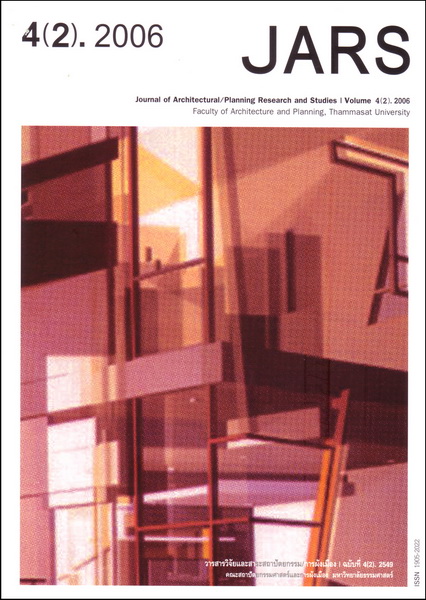Intuitive Dynamics: The Inscription of Time in MnG House
Main Article Content
Abstract
For a decade, the architectural work of an architect Pornchai Boonsom has been based on an exploration in ‘time’ and ‘dynamic movement’ of interactive forces in the context of Postmodernism and Consumerism in Thailand. His MnG House in Bangkok, completed in 2002, is a reflection of a new thinking in science, particularly an experiment on Henri Bergson’s philosophical concepts of the evolution of time and dynamic process of intuition.
In the early twentieth century, Bergson proposed what became the great breakthrough against the classical biology of Charles Darwin - the theory of evolution. He introduced a new notion of time as a ceaseless flow or flux – not a discrete unit. This concept has changed the way we understand life and universe, and the way we spatially conceive and perceive architecture through a linear time. Bergson’s another concept of intuition psychologically explains how we understand the reality of the world as a continual flow of life.
Pornchai Boonsom’s MnG House reflects the Bergsonian worldview both in architectural geometry
and spatial expression. The house could be defined as ‘the inscription or the writing of time’ through
architectural productions: an exemplar work manifesting a continual change of form without a beginning
or an end.
Downloads
Article Details

This work is licensed under a Creative Commons Attribution-NonCommercial-NoDerivatives 4.0 International License.
All material is licensed under the terms of the Creative Commons Attribution 4.0 International (CC-BY-NC-ND 4.0) License, unless otherwise stated. As such, authors are free to share, copy, and redistribute the material in any medium or format. The authors must give appropriate credit, provide a link to the license, and indicate if changes were made. The authors may do so in any reasonable manner, but not in any way that suggests the licensor endorses you or your use. The authors may not use the material for commercial purposes. If the authors remix, transform, or build upon the material, they may not distribute the modified material, unless permission is obtained from JARS. Final, accepted versions of the paper may be posted on third party repositories, provided appropriate acknowledgement to the original source is clearly noted.
References
Bataille, G. (1997). Architecture. Rethinking architecture: A reader in cultural theory. London: Routledge, 20-21.
Ballantyne, A. (2005). Georges Bataille. Architecture theory: A reader in philosophy and culture. New York: Continuum, 15-16.
Jenks, C. (1985). Modern movements in architecture. London: Penguin Books, 29-94.
Bergson, H. Creative evolution. New York: Dover Publications, 11.
Joad, C.E.M. (1957). Outline of Bergson’s philosophy. Guide to philosophy. New York: Dover Publications, 544.
Othavorn, N. (2002, August). Via Intuition: Interviewed with Pornchai Boonsom. Art 4D, 85, 78. Bangkok:
Corporation 4D.
Russel, B. (1995). History of western philosophy. London: Routledge, 763.
Kern, S. [1996]. The culture of time and space 1880-1918. Massachusette: Harvard University Press, 25.


